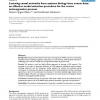766 search results - page 122 / 154 » Efficient gathering of correlated data in sensor networks |
BMCBI
2007
13 years 8 months ago
2007
Background: Causal networks based on the vector autoregressive (VAR) process are a promising statistical tool for modeling regulatory interactions in a cell. However, learning the...
MOBISYS
2007
ACM
14 years 8 months ago
2007
ACM
During mass casualty incidents, an enormous amount of data, including the vital signs of the patients, the location of the patients, and the location of the first responders must ...
JSAC
2006
13 years 8 months ago
2006
The responsiveness of networked applications is limited by communications delays, making network distance an important parameter in optimizing the choice of communications peers. S...
GISCIENCE
2008
Springer
13 years 9 months ago
2008
Springer
Movement patterns, like flocking and converging, leading and following, are examples of high-level process knowledge derived from lowlevel trajectory data. Conventional techniques...
AUSFORENSICS
2003
13 years 10 months ago
2003
This research looks at the efficiency of the honeyd honeypot system to reliably deceive intruders. Honeypots are being used as frontline network intelligence and forensic analysis...



